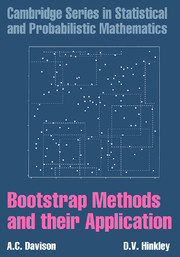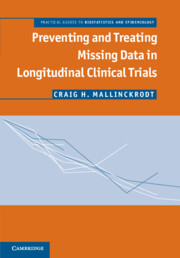Refine search
Actions for selected content:
2703 results in General statistics and probability
9 - Extended and unscented smoothing
-
- Book:
- Bayesian Filtering and Smoothing
- Published online:
- 05 June 2014
- Print publication:
- 05 September 2013, pp 144-153
-
- Chapter
- Export citation
4 - Bayesian filtering equations and exact solutions
-
- Book:
- Bayesian Filtering and Smoothing
- Published online:
- 05 June 2014
- Print publication:
- 05 September 2013, pp 51-63
-
- Chapter
- Export citation
Contents
-
- Book:
- Bayesian Filtering and Smoothing
- Published online:
- 05 June 2014
- Print publication:
- 05 September 2013, pp v-viii
-
- Chapter
- Export citation

Bootstrap Methods and their Application
-
- Published online:
- 05 June 2013
- Print publication:
- 28 October 1997

Genomic Clinical Trials and Predictive Medicine
-
- Published online:
- 05 February 2013
- Print publication:
- 07 January 2013

Preventing and Treating Missing Data in Longitudinal Clinical Trials
- A Practical Guide
-
- Published online:
- 05 February 2013
- Print publication:
- 28 January 2013
Part IV - Analyses and The Analytic Road Map
-
- Book:
- Preventing and Treating Missing Data in Longitudinal Clinical Trials
- Published online:
- 05 February 2013
- Print publication:
- 28 January 2013, pp 71-72
-
- Chapter
- Export citation
2 - Missing Data Mechanisms
-
- Book:
- Preventing and Treating Missing Data in Longitudinal Clinical Trials
- Published online:
- 05 February 2013
- Print publication:
- 28 January 2013, pp 9-14
-
- Chapter
- Export citation
14 - Example
-
- Book:
- Preventing and Treating Missing Data in Longitudinal Clinical Trials
- Published online:
- 05 February 2013
- Print publication:
- 28 January 2013, pp 129-146
-
- Chapter
- Export citation
Part I - Background and Setting
-
- Book:
- Preventing and Treating Missing Data in Longitudinal Clinical Trials
- Published online:
- 05 February 2013
- Print publication:
- 28 January 2013, pp 1-2
-
- Chapter
- Export citation
Index
-
- Book:
- Preventing and Treating Missing Data in Longitudinal Clinical Trials
- Published online:
- 05 February 2013
- Print publication:
- 28 January 2013, pp 161-165
-
- Chapter
- Export citation
Preface
-
- Book:
- Preventing and Treating Missing Data in Longitudinal Clinical Trials
- Published online:
- 05 February 2013
- Print publication:
- 28 January 2013, pp xvii-xviii
-
- Chapter
- Export citation
1 - Why Missing Data Matter
-
- Book:
- Preventing and Treating Missing Data in Longitudinal Clinical Trials
- Published online:
- 05 February 2013
- Print publication:
- 28 January 2013, pp 3-8
-
- Chapter
- Export citation
15 - Putting Principles into Practice
-
- Book:
- Preventing and Treating Missing Data in Longitudinal Clinical Trials
- Published online:
- 05 February 2013
- Print publication:
- 28 January 2013, pp 147-152
-
- Chapter
- Export citation
8 - Methods of Dealing with Missing Data
-
- Book:
- Preventing and Treating Missing Data in Longitudinal Clinical Trials
- Published online:
- 05 February 2013
- Print publication:
- 28 January 2013, pp 59-70
-
- Chapter
- Export citation
Part II - Preventing Missing Data
-
- Book:
- Preventing and Treating Missing Data in Longitudinal Clinical Trials
- Published online:
- 05 February 2013
- Print publication:
- 28 January 2013, pp 21-22
-
- Chapter
- Export citation
3 - Estimands
-
- Book:
- Preventing and Treating Missing Data in Longitudinal Clinical Trials
- Published online:
- 05 February 2013
- Print publication:
- 28 January 2013, pp 15-20
-
- Chapter
- Export citation
5 - Trial Conduct Considerations
-
- Book:
- Preventing and Treating Missing Data in Longitudinal Clinical Trials
- Published online:
- 05 February 2013
- Print publication:
- 28 January 2013, pp 33-36
-
- Chapter
- Export citation
Acknowledgments
-
- Book:
- Preventing and Treating Missing Data in Longitudinal Clinical Trials
- Published online:
- 05 February 2013
- Print publication:
- 28 January 2013, pp xv-xvi
-
- Chapter
- Export citation
13 - Analyzing Incomplete Categorical Data
-
- Book:
- Preventing and Treating Missing Data in Longitudinal Clinical Trials
- Published online:
- 05 February 2013
- Print publication:
- 28 January 2013, pp 121-128
-
- Chapter
- Export citation
